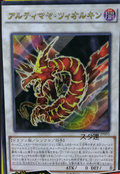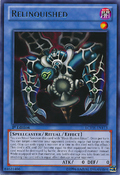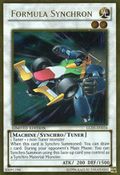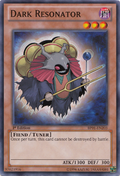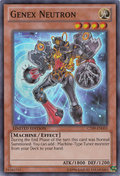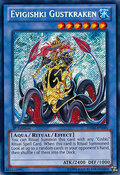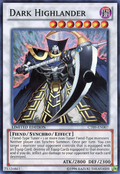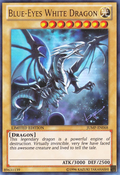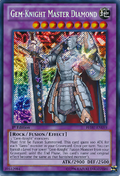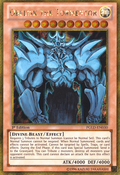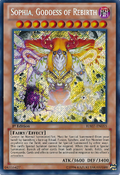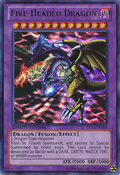Difference between revisions of "Level"
(Added Egyptian God cards to list of monsters that are Level 9 or higher.) |
Blueapple128 (talk | contribs) (Where does the 星 kanji ever appear? Cleanup) |
||
| Line 23: | Line 23: | ||
{{Infobox/Archetype/End}} | {{Infobox/Archetype/End}} | ||
| − | A [[Monster Card]]'s '''Level''' (Japanese: | + | A [[Monster Card]]'s '''Level''' (Japanese: レベル ''Reberu'') is a rough indication of a card's power level, represented by a number of stars [[File:CG Star.svg|18px]] in the top-right. Monsters' original Levels can range from 1 to 12. In the ''[[OCG]]'' and ''[[TCG]]'', monsters cannot have a Level lower than 1, but [[card effect]]s can freely raise a monster's Level above 12. In the ''[[Yu-Gi-Oh! 5D's]]'' anime and [[Yu-Gi-Oh! 5D's (manga)|manga]], as well as in the later ''[[Yu-Gi-Oh! Tag Force]]'' series of video games, [[Dark Synchro Monster]]s can be Level 0 or feature [[Negative Level]]s. [[Xyz Monster]]s have a [[Rank]] instead of a Level. |
| − | + | Barring any special restrictions printed on the card, monsters from Level 1 to Level 4 may be [[Normal Summon]]ed from the hand with no cost. Thus, Level 4 monsters are generally among the most commonly used monsters played in any [[Deck]]. Level 5 and 6 monsters require a [[Tribute]] to be Normal Summoned, and Level 7 or higher monsters require two [[Tribute]]s to be Normal Summoned. Level 9 and higher monsters are relatively rare, and almost always cannot be [[Normal Summon]]ed in the usual way, requiring special [[condition]]s printed on the card to Summon (or by residing in the [[Extra Deck]] rather than the Main Deck). Noteworthy exceptions include "[[Yubel]]", "[[World of Prophecy]]", and all of the "[[Earthbound Immortal]]" monsters. Such monsters are often the trump cards of any Deck that uses them. | |
| − | A common guideline is that Level 3 monsters generally have no more than 1750 ATK, Level 4 monsters have [[Level 4 ATK and DEF Rules|no more than 2000 ATK]], Level 6 monsters have no more than 2600 ATK, Level 8 monsters have [[Rule of 3000 ATK and DEF|no more than 3000 ATK]], Level 10 monsters have no more than 4000 ATK, and Level 12 monsters have no more than 5000 ATK. Monsters that break this rule generally have [[negative effect]]s or restrictive Summoning conditions. | + | A common guideline is that Level 3 monsters generally have no more than 1750 [[ATK]], Level 4 monsters have [[Level 4 ATK and DEF Rules|no more than 2000 ATK]], Level 6 monsters have no more than 2600 ATK, Level 8 monsters have [[Rule of 3000 ATK and DEF|no more than 3000 ATK]], Level 10 monsters have no more than 4000 ATK, and Level 12 monsters have no more than 5000 ATK. Monsters that break this rule generally have [[negative effect]]s or restrictive Summoning conditions that make them harder to use. |
| − | Level | + | Due to the higher requirements involved in Summoning them, higher-Level monsters are typically not as numerous as lower-Level monsters in a player's Deck, assuming the Deck is properly balanced. While high-Level monsters are usually considered the most effective in combat, it is often the low-Level monsters that perform the most important roles, due to their ease of use and often versatile [[card effect]]s such as [[search]]ing other cards out of the player's Deck. In addition, many low-Level monsters possess effects that can change their ATK, which in a well-supported Deck can often give them far higher ATK than any high-Level monster. For example, "[[Copycat]]" and "[[Relinquished]]" base their ATK upon the opponent's monster, the "[[Meklord Emperor|Meklord Emperors]]" can take the ATK power of the opponent's Synchro Monsters, and "[[King of the Skull Servants]]" can have an enormous ATK in the right Deck. |
| − | + | A monster's Level is also instrumental in [[Ritual]], [[Synchro]], [[Xyz]], and [[Pendulum Summon]]ing. Ritual Monsters require Tributing monsters whose combined Levels are equal to or greater than the Ritual Monster's Level in order to be Ritual Summoned. Synchro Monsters require the total Levels of the [[Tuner]] monster and the non-Tuner [[Synchro Material Monster]](s) to be exactly equal to the Synchro Monster's Level. Xyz Monsters require two or more [[Xyz Material]] monsters whose Levels are all equal to the Xyz Monster's Rank. Pendulum Summoning allows the simultaneous Summoning of multiple monsters as long as their Level is between the [[Pendulum Scale]]s of the cards in the [[Pendulum Zone]]s. | |
| − | + | As with [[Rank]]s, there is a single currently [[OCG exclusive]] monster that has been printed with a Level of 0, and whose [[condition]] treats it as a different Level at all times. | |
'''Examples:''' | '''Examples:''' | ||
<gallery heights="250px" captionalign="center"> | <gallery heights="250px" captionalign="center"> | ||
| + | UltimayaTzolkin-VJMP-JP-OP.png | A [[Level 0 Monster Cards|Level 0 monster]]. | ||
Relinquished-LCYW-EN-R-1E.png | A [[Level 1 Monster Cards|Level 1 monster]]. | Relinquished-LCYW-EN-R-1E.png | A [[Level 1 Monster Cards|Level 1 monster]]. | ||
FormulaSynchron-GLD5-EN-GUR-LE.jpg | A [[Level 2 Monster Cards|Level 2 monster]]. | FormulaSynchron-GLD5-EN-GUR-LE.jpg | A [[Level 2 Monster Cards|Level 2 monster]]. | ||
| Line 44: | Line 45: | ||
EvigishkiGustkraken-HA06-EN-ScR-1E.png | A [[Level 6 Monster Cards|Level 6 monster]]. | EvigishkiGustkraken-HA06-EN-ScR-1E.png | A [[Level 6 Monster Cards|Level 6 monster]]. | ||
DarkHighlander-CT09-EN-SR-LE.png | A [[Level 7 Monster Cards|Level 7 monster]]. | DarkHighlander-CT09-EN-SR-LE.png | A [[Level 7 Monster Cards|Level 7 monster]]. | ||
| − | BlueEyesWhiteDragon- | + | BlueEyesWhiteDragon-JUMP-EN-UR-LE.png | A [[Level 8 Monster Cards|Level 8 monster]]. |
GemKnightMasterDiamond-HA07-EN-ScR-1E.png | A [[Level 9 Monster Cards|Level 9 monster]]. | GemKnightMasterDiamond-HA07-EN-ScR-1E.png | A [[Level 9 Monster Cards|Level 9 monster]]. | ||
| − | ObelisktheTormentor-PGLD-EN-GScR-1E.png | + | ObelisktheTormentor-PGLD-EN-GScR-1E.png | A [[Level 10 Monster Cards|Level 10 monster]]. |
SophiaGoddessofRebirth-HA07-EN-ScR-1E.png | A [[Level 11 Monster Cards|Level 11 monster]]. | SophiaGoddessofRebirth-HA07-EN-ScR-1E.png | A [[Level 11 Monster Cards|Level 11 monster]]. | ||
| − | FiveHeadedDragon-LC03-EN-UR-LE.png | + | FiveHeadedDragon-LC03-EN-UR-LE.png | A [[Level 12 Monster Cards|Level 12 monster]]. |
</gallery> | </gallery> | ||
Revision as of 13:58, 11 December 2014
This article may require cleanup to meet this wiki's standards. |
| Level | |||
|---|---|---|---|
|
| |||
| Japanese |
| ||
| Japanese (ruby) |
レベル | ||
| Japanese (base text) |
星 | ||
| Japanese (romanized) |
Reberu | ||
| English |
Level | ||
| |||
A Monster Card's Level (Japanese: レベル Reberu) is a rough indication of a card's power level, represented by a number of stars in the top-right. Monsters' original Levels can range from 1 to 12. In the OCG and TCG, monsters cannot have a Level lower than 1, but card effects can freely raise a monster's Level above 12. In the Yu-Gi-Oh! 5D's anime and manga, as well as in the later Yu-Gi-Oh! Tag Force series of video games, Dark Synchro Monsters can be Level 0 or feature Negative Levels. Xyz Monsters have a Rank instead of a Level.
Barring any special restrictions printed on the card, monsters from Level 1 to Level 4 may be Normal Summoned from the hand with no cost. Thus, Level 4 monsters are generally among the most commonly used monsters played in any Deck. Level 5 and 6 monsters require a Tribute to be Normal Summoned, and Level 7 or higher monsters require two Tributes to be Normal Summoned. Level 9 and higher monsters are relatively rare, and almost always cannot be Normal Summoned in the usual way, requiring special conditions printed on the card to Summon (or by residing in the Extra Deck rather than the Main Deck). Noteworthy exceptions include "Yubel", "World of Prophecy", and all of the "Earthbound Immortal" monsters. Such monsters are often the trump cards of any Deck that uses them.
A common guideline is that Level 3 monsters generally have no more than 1750 ATK, Level 4 monsters have no more than 2000 ATK, Level 6 monsters have no more than 2600 ATK, Level 8 monsters have no more than 3000 ATK, Level 10 monsters have no more than 4000 ATK, and Level 12 monsters have no more than 5000 ATK. Monsters that break this rule generally have negative effects or restrictive Summoning conditions that make them harder to use.
Due to the higher requirements involved in Summoning them, higher-Level monsters are typically not as numerous as lower-Level monsters in a player's Deck, assuming the Deck is properly balanced. While high-Level monsters are usually considered the most effective in combat, it is often the low-Level monsters that perform the most important roles, due to their ease of use and often versatile card effects such as searching other cards out of the player's Deck. In addition, many low-Level monsters possess effects that can change their ATK, which in a well-supported Deck can often give them far higher ATK than any high-Level monster. For example, "Copycat" and "Relinquished" base their ATK upon the opponent's monster, the "Meklord Emperors" can take the ATK power of the opponent's Synchro Monsters, and "King of the Skull Servants" can have an enormous ATK in the right Deck.
A monster's Level is also instrumental in Ritual, Synchro, Xyz, and Pendulum Summoning. Ritual Monsters require Tributing monsters whose combined Levels are equal to or greater than the Ritual Monster's Level in order to be Ritual Summoned. Synchro Monsters require the total Levels of the Tuner monster and the non-Tuner Synchro Material Monster(s) to be exactly equal to the Synchro Monster's Level. Xyz Monsters require two or more Xyz Material monsters whose Levels are all equal to the Xyz Monster's Rank. Pendulum Summoning allows the simultaneous Summoning of multiple monsters as long as their Level is between the Pendulum Scales of the cards in the Pendulum Zones.
As with Ranks, there is a single currently OCG exclusive monster that has been printed with a Level of 0, and whose condition treats it as a different Level at all times.
Examples:
- See also Summoning Rules.

